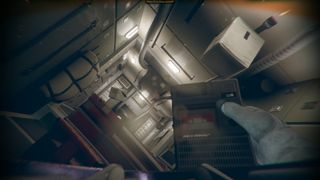Exploring an abandoned Soviet space station in Outreach
A wonderful and eerie venture into a lifeless world.

You, a lone Soviet cosmonaut, are sent to investigate a communications blackout on a space station. When you arrive the place is falling apart, the crew is missing, and it’s up to you to find out what happened to the station and the workers aboard it. Set in the ’80s, Outreach fuses real-world history with conspiracy theories. The environments are realistic, modeled on Russia’s famous Mir space station, meaning there’s no technology that didn’t exist at the time. Developer Pixel Spill spent months researching the era, and it shows. Everything from computer consoles to clothing has a feel of authenticity. It’s like stepping back in time.
And this realism extends to the way you navigate the station, with zero gravity to deal with. You can push against scenery to propel your body forward, or grab railings to pull yourself along. It’s slightly headspinning at first, and adjusting to the fact that there’s no up or down takes some getting used to. But when you master it, floating around is a lot of fun. And when you realise that you can grab objects, throw them, and watch them spin through the air realistically, the story will take a temporary backseat as you experiment and play around with the physics. The zero-gravity movement feels just right, which is the result of a lot of painstaking tweaking and adjusting by Pixel Spill.

There’s something wonderfully eerie about the lifeless station. Abandoned space stations are nothing new in games, but the realism element in Outreach makes it feel unique. The chunky tech is reminiscent of Alien: Isolation, which Pixel Spill cites as a big influence on the art design. I drift through the station discovering remnants of the mysteriously missing crew: conversations recorded on cassette tapes, letters, and family photos. I methodically check each and every module for clues, but find nothing. Then I reach a door with a broken handle, meaning I’m going to have to go for a spacewalk to reach the next area.
When I step outside into the expanse of space, the size of the Earth below makes me feel dizzy. The sense of scale is incredible. And while I felt relatively safe in the confines of the station, out here I’m suddenly overwhelmed by dread. A sensation that’s justified when I try and leap towards a handrail, only to miss, float helplessly away and die horribly in the depths of space.

This section is remarkably tense, requiring patience, timing, and concentration to carefully grab each rail and pull yourself to a distant airlock. You have to hit the grab button at precisely the right time, otherwise you’ll overshoot the rail and drift away from the station with no way to make your way back. I make it eventually, but I die several times in the process. Then, cruelly, the demo ends, and I don’t get to see what’s inside.
Outreach is fascinating, but my demo leaves me none the wiser about what kind of story it’ll tell. Will it be a psychological thriller? Or is there something supernatural going on aboard the station? I’m looking forward to finding out in the finished game. Pixel Spill promises players will “discover the lives and motivations of the crew” and learn about something called Project Outreach, which sounds suitably sinister.
The developer also says that you’ll uncover “the true nature” of the space station as you explore it, which is filling my head with questions. I’m told the game will be a relatively short experience—maybe three or four hours, the length of a long movie—and I’m okay with that. Short, focused, well-told stories are fast becoming one of my favourite kinds of game on PC, and I hope Outreach is one that delivers
The biggest gaming news, reviews and hardware deals
Keep up to date with the most important stories and the best deals, as picked by the PC Gamer team.
If it’s set in space, Andy will probably write about it. He loves sci-fi, adventure games, taking screenshots, Twin Peaks, weird sims, Alien: Isolation, and anything with a good story.
Most Popular


